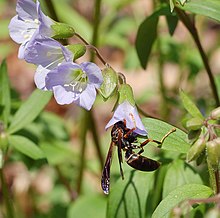pt-BR
nomes no trilho de navegação


Polemonium reptans is a perennial herbaceous plant native to eastern North America. Common names include spreading Jacob's ladder, creeping Jacob's ladder, false Jacob's ladder, abscess root, American Greek valerian, blue bells, stairway to heaven, and sweatroot.
Jacob's ladder grows 50 centimetres (20 in) tall, with pinnate leaves up to 20 centimetres (8 in) long with 5–13 leaflets. The leaves and flower stems grow from a vertical crown with abundant fibrous roots.[1]
The flowers are produced in panicles on weak stems from mid to late spring. They are 1.3 cm (1⁄2 in) long and have five light blue-violet petals that are fused at the base, enclosed by a tubular calyx with five pointed lobes.[1] The pollen is white. The stigma extends beyond the anthers, making self-pollination difficult, so insects must cross-pollinate for the plants to produce seed.[2]
Pollinated flowers develop into an oval pod with three chambers, 6 mm (1⁄2 in) long, which is enclosed by the green calyx. The plant spreads by reseeding itself. The Latin specific epithet reptans means creeping.[3]

The flowers produce both pollen and nectar. Long- and short-tongued bees visit the plants for both nectar and pollen, syrphid flies and fire beetles (Pedilus lugubris) feed on pollen, and butterflies and moths drink nectar. Out of these insects, large bees are the most effective at cross-pollination, since they most often touch the pollen-covered anthers.[2]
Polemonium reptans is typically found in rich, moist woods, often along streambanks.[4][5] Its range extends from Minnesota to New Hampshire in the north, and from Georgia to Mississippi in the south.[5] It is most abundant west of the Appalachian Mountains.[4][5]

The plant prefers partial shade and mesic soil. It tolerates full sun, but requires constantly moist soil.[2]
The dried roots have a slightly bitter and acrid taste. P. reptans has been traditionally used as an herbal medicine for febrile and inflammatory diseases, to ease coughs, colds and bronchial complaints, and to encourage perspiration.[6] It is furthermore said to bring relief in cases of inflammations and infections.[7] The root is rarely used in modern herbalism. It is harvested in the autumn and dried for later use.
Polemonium reptans is a perennial herbaceous plant native to eastern North America. Common names include spreading Jacob's ladder, creeping Jacob's ladder, false Jacob's ladder, abscess root, American Greek valerian, blue bells, stairway to heaven, and sweatroot.
Polemonium reptans
La polémoine rampante (Polemonium reptans) est une plante à fleur de la famille des Polemoniaceae, originaire d'Amérique du Nord.
Dvergastigi (fræðiheiti: polemonium reptans) er dulfrævingur sem á rætur sínar að rekja til austurhluta Norður-Ameríku.
Fyrirmynd greinarinnar var „Polemonium reptans“ á ensku útgáfu Wikipedia. Sótt 22. janúar 2010.
Dvergastigi (fræðiheiti: polemonium reptans) er dulfrævingur sem á rætur sínar að rekja til austurhluta Norður-Ameríku.
Polemonium reptans é uma espécie pertencente ao gênero Polemonium, nativa do leste da América do Norte.[1]
Polemonium reptans é uma espécie pertencente ao gênero Polemonium, nativa do leste da América do Norte.
Polemonium reptans, Polemoniaceae familyasından anavatanı Kuzey Amerika olan otsu bir bitki türü.
50 cm uzunluğa kadar çıkabilen çok yıllık otsu bitkilerdir. Tüysü yapraklar 20 cm uzunluğunda olup 5-13 yaprakçıktan oluşur. Korollası beş loplu olan çiçek mavimsi-eflatun renklidir.
Kurutulmuş köklerin hafif buruk ve acı tadı vardır. Deri sağlığı ve zehir sokması da dahil olmak üzere öksürük, nezle, bronşit, larenjit, tüberküloz ile ateşli ve iltihaplı hastalıkların tedavisinde kullanılır. Daha sonra kullanıma sunmak için sonbaharda hasat edilerek kurutulur.
Polemonium reptans, Polemoniaceae familyasından anavatanı Kuzey Amerika olan otsu bir bitki türü.
Синюха ползучая (лат. Polemonium reptans) — вид цветковых растений рода Синюха (Polemonium) родом из восточной части Северной Америки. Некоторые источники не признают выделения этого вида[1].
Многолетнее травянистое растение высотой до 50 см с перистыми листьями до 20 см длиной, состоящими из 5—13 листочков. Цветки от голубого до фиолетового цвета, с пятилопастным венчиком длиной до 1,3 см.
Как правило, произрастает во влажных густых лесах, нередко по берегам рек[2][3]. Ареал простирается от Миннесоты до Нью-Гэмпшира на севере и от Джорджии до Миссисипи на юге[3]. Вид наиболее многочисленнен к западу от гор Аппалачи[2][3].
Выращивается как декоративное садовое растение[4].
Растение применяется и в лечебных целях. Осенью корни собирают и сушат. Они имеют слегка горьковатый и едкий вкус. Используется для лечения кашля, простуды, лихорадки, бронхита, ларингита, туберкулеза. Она также применяется наружно в случаях различных укусов.
Синюха ползучая (лат. Polemonium reptans) — вид цветковых растений рода Синюха (Polemonium) родом из восточной части Северной Америки. Некоторые источники не признают выделения этого вида.
匍匐花荵(學名:Polemonium reptans)是花荵屬的一種開花植物,原產於北美洲東部。
匍匐花荵是多年生的草本植物,可以長達50厘米高。葉子為羽狀複葉,長20厘米,有5-13小葉。花朵呈藍至紫色,長1.3厘米,花冠有五葉。
匍匐花荵根略苦及辛辣。它們可以用來治療咳嗽、普通感冒、支氣管炎、喉炎、結核、熱症及炎症等。現今的草藥醫術很少會處方匍匐花荵根。它們可以於秋天收取,曬乾來日後使用。